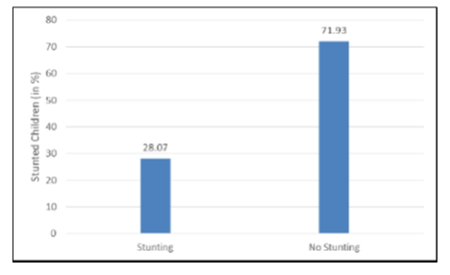
Geographical analysis
Department of Geography & GIS

Department of Geography & GIS

Geographical analysis
Year: 2020, Volume: 9, Issue: 2, Pages: 27-32
Original Article
Dhiren Sahoo1, Archana Kujur2
1Research Scholar, Department of Geography, Central University of Karnataka, 585367, Karnataka
2Assistant professor, Department of Geography, Central University of Karnataka, 585367,
Karnataka
Received Date:19 August 2020, Accepted Date:22 November 2020
Introduction: The literature suggests that children living in the areas with widespread opendefecation, lack of access to safe drinking water and provision of hand hygiene are exposed to a higher level of microbial contamination. These conditions often keep children undernourished, diminishes their cognitive skills leading to intergenerational poverty. Methods: Using the individual and household data from Indian Human Development Survey 2012 (IHDS II), the study used binary logistic model to analyse the impact of household-based water, sanitation and hygiene (WASH) and health outcome of the children in the Empowered Action Group (EAG) states of India. Results: The study suggested that having access to safe water, the chances of being not stunted are 20 per cent lower compared to the children accessing unsafe water. Similarly, children who have a household toilet and practice better hand hygiene, have 20 per cent higher chances of being not stunted against open defecating children and children who do not practice hand-hygiene habits. Other than WASH, the children’s demographic traits of being at a higher age, being female over male, indicated a significantly higher odds of being stunted. Conclusion: The empirical findings suggests that WASH has the ability to guide the child related policies with concrete approaches. Since the three components of the WASH are interdisciplinary it is suggested that combined WASH intervention have massive personal
Alacevich, C., & Tarozzi, A. (2017). Child height and intergenerational transmission of health: Evidence from ethnic Indians in England. Economics and Human Biology, 25, 65–84. https://doi.org/10.1016/j.ehb.2016.10.004
Bhandari, N., Bahl, R., Taneja, S., De Onis, M., & Bhan, M. K. (2002). Growth performance of affluent Indian children is similar to that in developed countries. Bulletin of the World Health Organization. https://doi.org/10.1590/S0042-96862002000300004
Coffey, D., Deaton, A., Drèze, J., Spears, D., & Tarozzi, A. (2013). Stunting among children: Facts and implications. Economic and Political Weekly.
Deaton, A., & Drèze, J. (2009). Food and nutrition in India: Facts and interpretations. Economic and Political Weekly.
Desai, S., & Vanneman, R. (2018). India Human Development Survey-II (IHDS-II), 2011-12. Inter-university Consortium for Political and Social Research [distributor]. https://doi.org/10.3886/ICPSR36151.v6Food and Agriculture Organization of the United Nations.
Grassi, Flavia; Landberg, Josefine; Huyer, S. (2015). Running out of time: The reduction of women’s work burden in agricultural production. Food and Agriculture Organization of the United Nations.
Habicht, J. P., Yarbrough, C., Martorell, R., Malina, R. M., & Klein, R. E. (1974). HEIGHT AND WEIGHT STANDARDS FOR PRESCHOOL CHILDREN. HOW RELEVANT ARE ETHNIC DIFFERENCES IN GROWTH POTENTIAL ? The Lancet. https://doi.org/10.1016/S0140-6736(74)92663-4
Humphrey, J. H. (2009). Child under nutrition, tropical enteropathy, toilets, and handwashing. The Lancet. https://doi.org/10.1016/S0140-6736(09)60950-8
Indian Institute for Population Sciences (IIPS) and ICF. (2017). National Family Health Survey (NFHS-4), 2015-16: India. International Institute for Population Sciences (IIPS) and ICF. https://doi.org/kwm120 [pii]10.1093/aje/kwm120
Montgomery, M. A., & Elimelech, M. (2007). Water And Sanitation in Developing Countries: Including Health in the Equation. Environmental Science & Technology. https://doi.org/10.1021/es072435t
Prendergast, A. J., & Humphrey, J. H. (2014). The stunting syndrome in developing countries. Paediatrics and International Child Health. https://doi.org/10.1179/2046905514Y.0000000158
Ramalingaswami, V., Jonsson, U., & Rohde, J. (1996). The Asian enigma. In The progress of nations.
Spears, D. (2013). How Much International Variation in Child Height Can Sanitation Explain? World Bank Policy Research Working Paper. https://doi.org/http://www-wds.worldbank.org/servlet/WDSContentServer/WDSP/IB/2013/02/05/000158349_20130205082533/Rendered/PDF/wps6351.pdf
Spears, D., Ghosh, A., & Cumming, O. (2013). Open Defecation and Childhood Stunting in India: An Ecological Analysis of New Data from 112 Districts. PLoS ONE, 8(9), e73784. https://doi.org/10.1371/journal.pone.0073784
Steckel, R. H. (2009). Heights and human welfare: Recent developments and new directions. Explorations in Economic History. https://doi.org/10.1016/j.eeh.2008.12.001
WHO. (2012). Country Profile Indicators: Interpretation Guide. Nutrition Landacape Information System (NLIS). https://doi.org/10.1159/000362780. Interpretation
WHO. (2018). Core questions on water, sanitation and hygiene for household surveys 2018. Joint Monitoring Programme. Retrieved from https://data.unicef.org/wp-content/uploads/2020/04/JMP-2018-core-questions-for-household-surveys-1.pdf
© 2020 Sahoo & Kujur. This is an open-access article distributed under the terms of the Creative Commons Attribution License, which permits unrestricted use, distribution, and reproduction in any medium, provided the original author and source are credited.
Published By Bangalore University, Bengaluru, Karnataka
Subscribe now for latest articles and news.